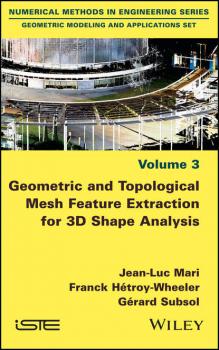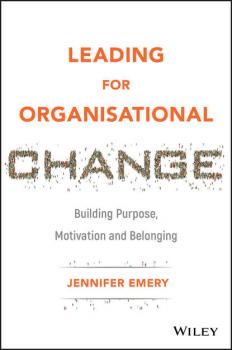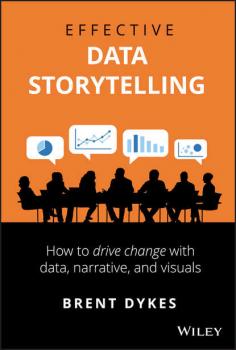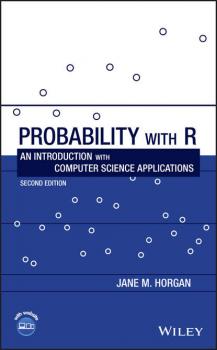ТОП просматриваемых книг сайта:
Математика
Различные книги в жанре Математика, доступные для чтения и скачиванияАннотация
В настоящем пособии приведены подробные решения примеров по теме «Предел функции одной переменной» без использования производной. Вначале сформулированы основные определения и теоремы, затем рассмотрены конкретные примеры. Попутно приведены без вывода формулы, которые используются при решении большинства примеров. В конце предложены примеры для самоконтроля с ответами. Направления и профили подготовки: 22.03.01 Материаловедение и технологии материалов, 03.03.02 Физика, 11.03.04 Электроника и наноэлектроника, 28.03.01 Нанотехнология и микросистемная техника, 28.03.03 Наноматериалы.
Аннотация
Если вам не давалась математика, возможно, дело было не в вас, а в том, как вам ее преподносили. Эту книгу можно назвать провокацией. Предложенный подход к изучению математики меняет привычное представление о ней как о скучной и абстрактной дисциплине, которую нужно просто вызубрить. Автор вместе с читателем создает математическую вселенную, увлекательную и увлекающую. Он не постулирует математические концепции, а постепенно выводит их из нашего понимания окружающего мира. По мнению Джейсона Уилкса, система образования блестяще сконструирована, чтобы наказывать творческие способности; чтобы учить, как правильно писать математические символы, а не думать самостоятельно. Его книга будет для вас умным и немного безумным учителем, который поможет дойти до открытий и определений самостоятельно, а не заучивать их. Важное замечание: эта книга может стать прекрасным дополнением к любому стандартному учебнику, но не заменить его!
Аннотация
Three-dimensional surface meshes are the most common discrete representation of the exterior of a virtual shape. Extracting relevant geometric or topological features from them can simplify the way objects are looked at, help with their recognition, and facilitate description and categorization according to specific criteria. This book adopts the point of view of discrete mathematics, the aim of which is to propose discrete counterparts to concepts mathematically defined in continuous terms. It explains how standard geometric and topological notions of surfaces can be calculated and computed on a 3D surface mesh, as well as their use for shape analysis. Several applications are also detailed, demonstrating that each of them requires specific adjustments to fit with generic approaches. The book is intended not only for students, researchers and engineers in computer science and shape analysis, but also numerical geologists, anthropologists, biologists and other scientists looking for practical solutions to their shape analysis, understanding or recognition problems.
Аннотация
Provides an overview of the developments and advances in the field of network clustering and blockmodeling over the last 10 years This book offers an integrated treatment of network clustering and blockmodeling, covering all of the newest approaches and methods that have been developed over the last decade. Presented in a comprehensive manner, it offers the foundations for understanding network structures and processes, and features a wide variety of new techniques addressing issues that occur during the partitioning of networks across multiple disciplines such as community detection, blockmodeling of valued networks, role assignment, and stochastic blockmodeling. Written by a team of international experts in the field, Advances in Network Clustering and Blockmodeling offers a plethora of diverse perspectives covering topics such as: bibliometric analyses of the network clustering literature; clustering approaches to networks; label propagation for clustering; and treating missing network data before partitioning. It also examines the partitioning of signed networks, multimode networks, and linked networks. A chapter on structured networks and coarsegrained descriptions is presented, along with another on scientific coauthorship networks. The book finishes with a section covering conclusions and directions for future work. In addition, the editors provide numerous tables, figures, case studies, examples, datasets, and more. Offers a clear and insightful look at the state of the art in network clustering and blockmodeling Provides an excellent mix of mathematical rigor and practical application in a comprehensive manner Presents a suite of new methods, procedures, algorithms for partitioning networks, as well as new techniques for visualizing matrix arrays Features numerous examples throughout, enabling readers to gain a better understanding of research methods and to conduct their own research effectively Written by leading contributors in the field of spatial networks analysis Advances in Network Clustering and Blockmodeling is an ideal book for graduate and undergraduate students taking courses on network analysis or working with networks using real data. It will also benefit researchers and practitioners interested in network analysis.
Estimation of Stochastic Processes with Stationary Increments and Cointegrated Sequences - Maksym Luz
Аннотация
Estimation of Stochastic Processes is intended for researchers in the field of econometrics, financial mathematics, statistics or signal processing. This book gives a deep understanding of spectral theory and estimation techniques for stochastic processes with stationary increments. It focuses on the estimation of functionals of unobserved values for stochastic processes with stationary increments, including ARIMA processes, seasonal time series and a class of cointegrated sequences. Furthermore, this book presents solutions to extrapolation (forecast), interpolation (missed values estimation) and filtering (smoothing) problems based on observations with and without noise, in discrete and continuous time domains. Extending the classical approach applied when the spectral densities of the processes are known, the minimax method of estimation is developed for a case where the spectral information is incomplete and the relations that determine the least favorable spectral densities for the optimal estimations are found.
Аннотация
Harness the seven key elements of successful organisational change Leading for Organisational Change is an intelligent and practical guide to the human side of merger integration and other organisational change. Building a clear sense of common purpose and then reinforcing it through storytelling can underpin the success of an integration or significant change programme. Pulling together the best thinking from neuroscience, psychology and business, and her rich personal experience in twenty years of leading change projects in professional services organisations and other people-centred businesses, author Jennifer Emery presents a framework for change rooted in seven key themes that help organisations establish their BECAUSE: belonging, evolution, confidence, agility, understanding, simplicity and energy. Exploring the role each theme plays in the context of change, this insightful and warm book shares real-world examples and provides advice on building purpose and culture and strengthening motivation through listening, empowering and collaborating. Clear understanding of purpose, powerful communication techniques and carefully planned implementation strategies assist in navigating an often stressful and uncertain period of change, and can even enable organisations to thrive throughout this period. This book encourages you to apply important lessons to your own context, allowing you to: Focus on the human, cultural and practical elements of organisational change Apply central concepts of communication and motivation to a wide array of situations in your personal and business life Understand perspectives on change from a broad range of professional sectors Build and strengthen communication skills to promote a sense of shared purpose Leading for Organisational Change offers a warm and intelligent perspective on the personal and inter-personal factors that contribute to successful integration. An invaluable resource for professional services and people-focused organisations, this book provides advice that can cross sectors and lend insight to any major change programme.
Аннотация
Master the art and science of data storytelling—with frameworks and techniques to help you craft compelling stories with data. The ability to effectively communicate with data is no longer a luxury in today’s economy; it is a necessity. Transforming data into visual communication is only one part of the picture. It is equally important to engage your audience with a narrative—to tell a story with the numbers. Effective Data Storytelling will teach you the essential skills necessary to communicate your insights through persuasive and memorable data stories. Narratives are more powerful than raw statistics, more enduring than pretty charts. When done correctly, data stories can influence decisions and drive change. Most other books focus only on data visualization while neglecting the powerful narrative and psychological aspects of telling stories with data. Author Brent Dykes shows you how to take the three central elements of data storytelling—data, narrative, and visuals—and combine them for maximum effectiveness. Taking a comprehensive look at all the elements of data storytelling, this unique book will enable you to: Transform your insights and data visualizations into appealing, impactful data stories Learn the fundamental elements of a data story and key audience drivers Understand the differences between how the brain processes facts and narrative Structure your findings as a data narrative, using a four-step storyboarding process Incorporate the seven essential principles of better visual storytelling into your work Avoid common data storytelling mistakes by learning from historical and modern examples Effective Data Storytelling: How to Drive Change with Data, Narrative and Visuals is a must-have resource for anyone who communicates regularly with data, including business professionals, analysts, marketers, salespeople, financial managers, and educators.
Аннотация
Provides a comprehensive introduction to probability with an emphasis on computing-related applications This self-contained new and extended edition outlines a first course in probability applied to computer-related disciplines. As in the first edition, experimentation and simulation are favoured over mathematical proofs. The freely down-loadable statistical programming language R is used throughout the text, not only as a tool for calculation and data analysis, but also to illustrate concepts of probability and to simulate distributions. The examples in Probability with R: An Introduction with Computer Science Applications, Second Edition cover a wide range of computer science applications, including: testing program performance; measuring response time and CPU time; estimating the reliability of components and systems; evaluating algorithms and queuing systems. Chapters cover: The R language; summarizing statistical data; graphical displays; the fundamentals of probability; reliability; discrete and continuous distributions; and more. This second edition includes: improved R code throughout the text, as well as new procedures, packages and interfaces; updated and additional examples, exercises and projects covering recent developments of computing; an introduction to bivariate discrete distributions together with the R functions used to handle large matrices of conditional probabilities, which are often needed in machine translation; an introduction to linear regression with particular emphasis on its application to machine learning using testing and training data; a new section on spam filtering using Bayes theorem to develop the filters; an extended range of Poisson applications such as network failures, website hits, virus attacks and accessing the cloud; use of new allocation functions in R to deal with hash table collision, server overload and the general allocation problem. The book is supplemented with a Wiley Book Companion Site featuring data and solutions to exercises within the book. Primarily addressed to students of computer science and related areas, Probability with R: An Introduction with Computer Science Applications, Second Edition is also an excellent text for students of engineering and the general sciences. Computing professionals who need to understand the relevance of probability in their areas of practice will find it useful.
Аннотация
This monograph studies the relationships between fractional Brownian motion (fBm) and other processes of more simple form. In particular, this book solves the problem of the projection of fBm onto the space of Gaussian martingales that can be represented as Wiener integrals with respect to a Wiener process. It is proved that there exists a unique martingale closest to fBm in the uniform integral norm. Numerical results concerning the approximation problem are given. The upper bounds of distances from fBm to the different subspaces of Gaussian martingales are evaluated and the numerical calculations are involved. The approximations of fBm by a uniformly convergent series of Lebesgue integrals, semimartingales and absolutely continuous processes are presented. As auxiliary but interesting results, the bounds from below and from above for the coefficient appearing in the representation of fBm via the Wiener process are established and some new inequalities for Gamma functions, and even for trigonometric functions, are obtained.
Аннотация
Presents a useful guide for applications of SEM whilst systematically demonstrating various SEM models using M plus Focusing on the conceptual and practical aspects of Structural Equation Modeling (SEM), this book demonstrates basic concepts and examples of various SEM models, along with updates on many advanced methods, including confirmatory factor analysis (CFA) with categorical items, bifactor model, Bayesian CFA model, item response theory (IRT) model, graded response model (GRM), multiple imputation (MI) of missing values, plausible values of latent variables, moderated mediation model, Bayesian SEM, latent growth modeling (LGM) with individually varying times of observations, dynamic structural equation modeling (DSEM), residual dynamic structural equation modeling (RDSEM), testing measurement invariance of instrument with categorical variables, longitudinal latent class analysis (LLCA), latent transition analysis (LTA), growth mixture modeling (GMM) with covariates and distal outcome, manual implementation of the BCH method and the three-step method for mixture modeling, Monte Carlo simulation power analysis for various SEM models, and estimate sample size for latent class analysis (LCA) model. The statistical modeling program Mplus Version 8. 2 is featured with all models updated. It provides researchers with a flexible tool that allows them to analyze data with an easy-to-use interface and graphical displays of data and analysis results. Intended as both a teaching resource and a reference guide, and written in non-mathematical terms, Structural Equation Modeling: Applications Using Mplus, 2nd edition provides step-by-step instructions of model specification, estimation, evaluation, and modification. Chapters cover: Confirmatory Factor Analysis (CFA); Structural Equation Models (SEM); SEM for Longitudinal Data; Multi-Group Models; Mixture Models; and Power Analysis and Sample Size Estimate for SEM. Presents a useful reference guide for applications of SEM while systematically demonstrating various advanced SEM models Discusses and demonstrates various SEM models using both cross-sectional and longitudinal data with both continuous and categorical outcomes Provides step-by-step instructions of model specification and estimation, as well as detailed interpretation of M plus results using real data sets Introduces different methods for sample size estimate and statistical power analysis for SEM Structural Equation Modeling is an excellent book for researchers and graduate students of SEM who want to understand the theory and learn how to build their own SEM models using M plus.










